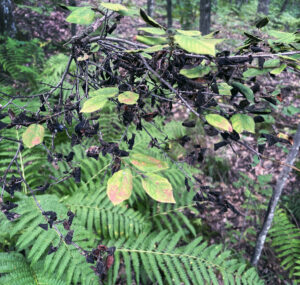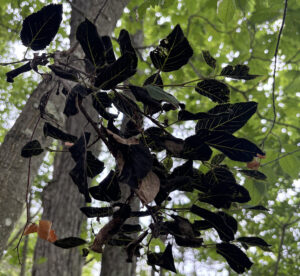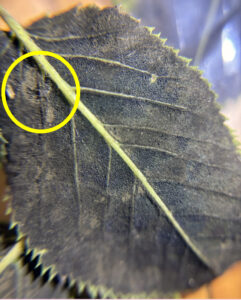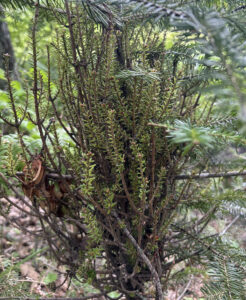
Witches’ broom on serviceberry. The leaves of this infected shrub are dying because of prolific spore production on their undersides. / Photo Credit: Wisconsin DNR
By Tim Shively, DNR Forest Health Specialist, Eau Claire
Tim.Shively@wisconsin.gov or 608-772-6974
Witches’ broom is a term that describes a disease of many different plants. It’s a distinctive, abnormal growth typically caused by a pathogen — though in some cases it can result from insect feeding.
The namesake symptom appears as abnormally dense clusters of stunted shoots, branches, and foliage that strongly resemble a witch’s broom from storybooks and folklore. In Wisconsin, this is not often a critical forest health concern that merits management action, but Wisconsin Department of Natural Resources Forest Health staff recently observed widespread incidence of two particular witches’ broom diseases.

Infected serviceberry leaves appear black with contrasting, light-green veins visible from underneath. This occurs in midsummer and can be differentiated from sooty mold because it restricted to the undersides of the leaves. / Photo Credit: Wisconsin DNR
Serviceberry Witches’ Broom
Witches’ broom on serviceberry (Amelanchier spp., also called juneberry, shadbush and saskatoon) is caused by the fungus Apiosporina collinsii. Infection occurs when fungal spores land, germinate and grow into weak points along the host plant’s twigs and leaf axils. Not much can be done to prevent this.
The infections are perennial, and the fungus grows through the branches out toward the buds, foliage and flowers with each year’s successive growth, causing the visible manifestation of the broom.
A sign of this particular witches’ broom is numerous fruiting bodies (called pseudothecia) on the undersides of leaves, which disperse spores on wind and rain to new hosts or even other areas of the same host plant. From underneath, the leaves appear black, with the veins still bright green in contrast.
At first glance, these fruiting bodies may resemble another, much more common fungal disease called sooty mold. However, sooty mold is typically seen on the upper surface of the leaf and can be an indicator of heavy insect feeding in the canopy above.

Fruiting bodies of the fungus that causes serviceberry witches’ broom cover the underside of a leaf, with the heaviest concentration circled. These fungi grow only on the undersides of leaves, dispersing spores, and killing the foliage. / Photo Credit: Wisconsin DNR
Healthy, mature serviceberry shrubs can often keep infections limited to a few branches. However, heavier infections can occur, especially in younger plants. This can be stressful, causing premature leaf drop and compensatory flushes of new foliage. Infections can eventually contribute to mortality. Several serviceberry shrubs in Chippewa County, varying from 8 to 15 feet tall, were recently observed with multiple brooms and significant defoliation.
While chemical control can be a potential treatment for residential or commercial settings, the only plausible treatment in the forest is to remove infected plants or prune out symptomatic branches. Be careful to sanitize tools between cuts and properly discard infected plant material. This method could advance certain management objectives, such as supporting wildlife and promoting species diversity, but it may not be worthwhile in many stands.
Fir-Broom Rust

Witches’ broom on balsam fir (Abies balsamea). Rust-colored spores will be visible emerging from stunted foliage during midsummer. / Photo Credit: Wisconsin DNR
Witches’ broom on balsam fir (Abies balsamea) is also caused by a fungus (Melamsporella elatina), but this pathogen is part of a group called the “rusts.” Rust fungi get their name from their bright orange, powdery spores that can resemble rusting metal. They can have complicated life cycles that involve two different host plants.
In the case of fir-broom rust, some familiar alternate hosts include nonnative chickweed (Stellaria media) and mouse-ear chickweed (Cerastium fontanum), as well as some closely related native species.
Witches’ broom in fir trees is often upright in form and can even look like a smaller tree perched on a branch. When young trees are infected, it can permanently alter the form of the tree.
The pathogen can also infect the stems of mature trees, killing them and even causing widespread mortality throughout a stand, which is known to occur on a few fir species in the western U.S. and in Europe.
Proactive management by ensuring infected planting stock is never used when plantations are established, as well as removing symptomatic branches and trees in natural stands managed for fir, are the most effective treatments. Another method is to reduce or remove the alternate hosts.
Because the main culprits are nonnative species (i.e., certain chickweeds), they can be highly abundant where they are established and provide ample resources for the pathogen. In this manner, a good invasive plant management plan can contribute to forest health in several ways.
